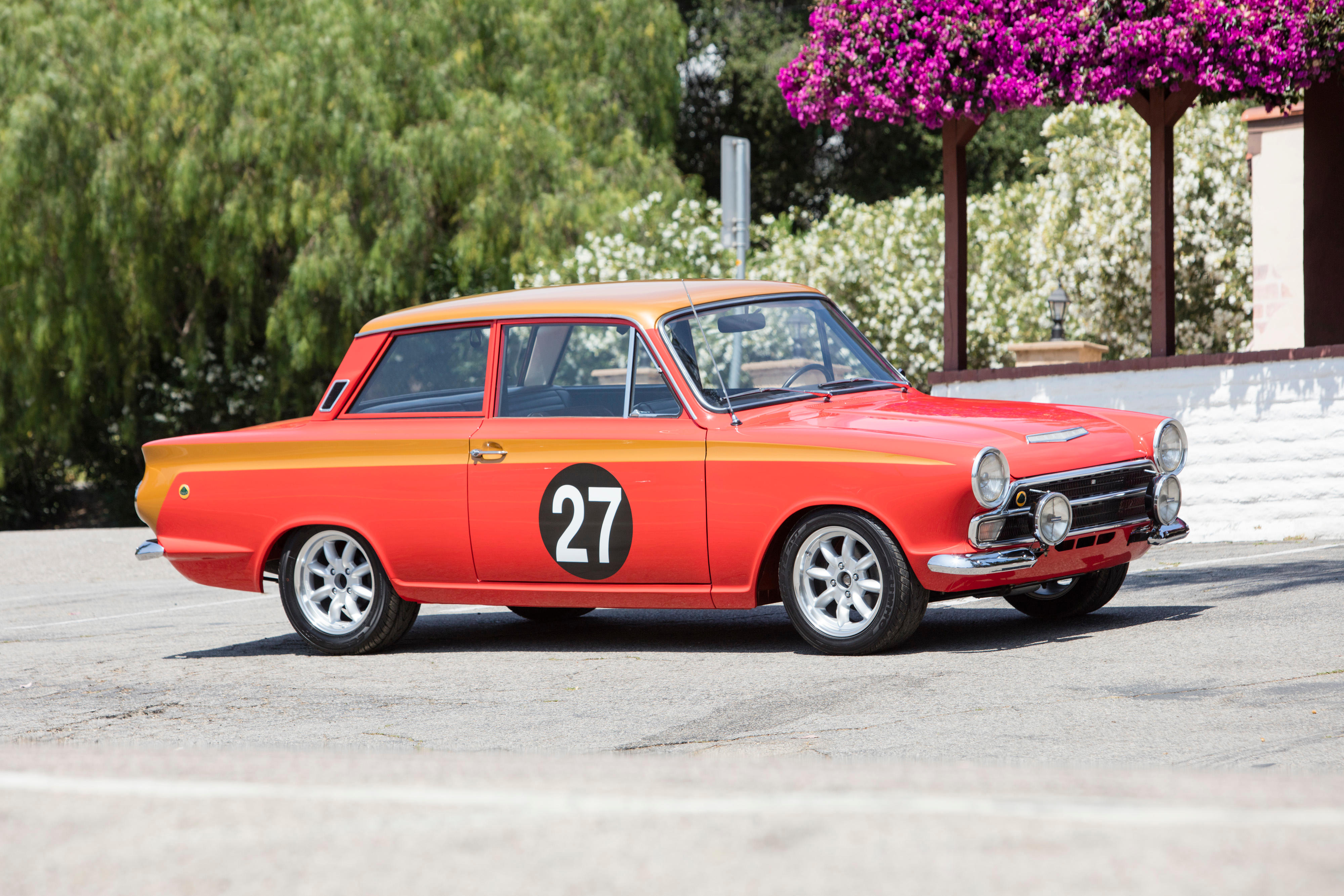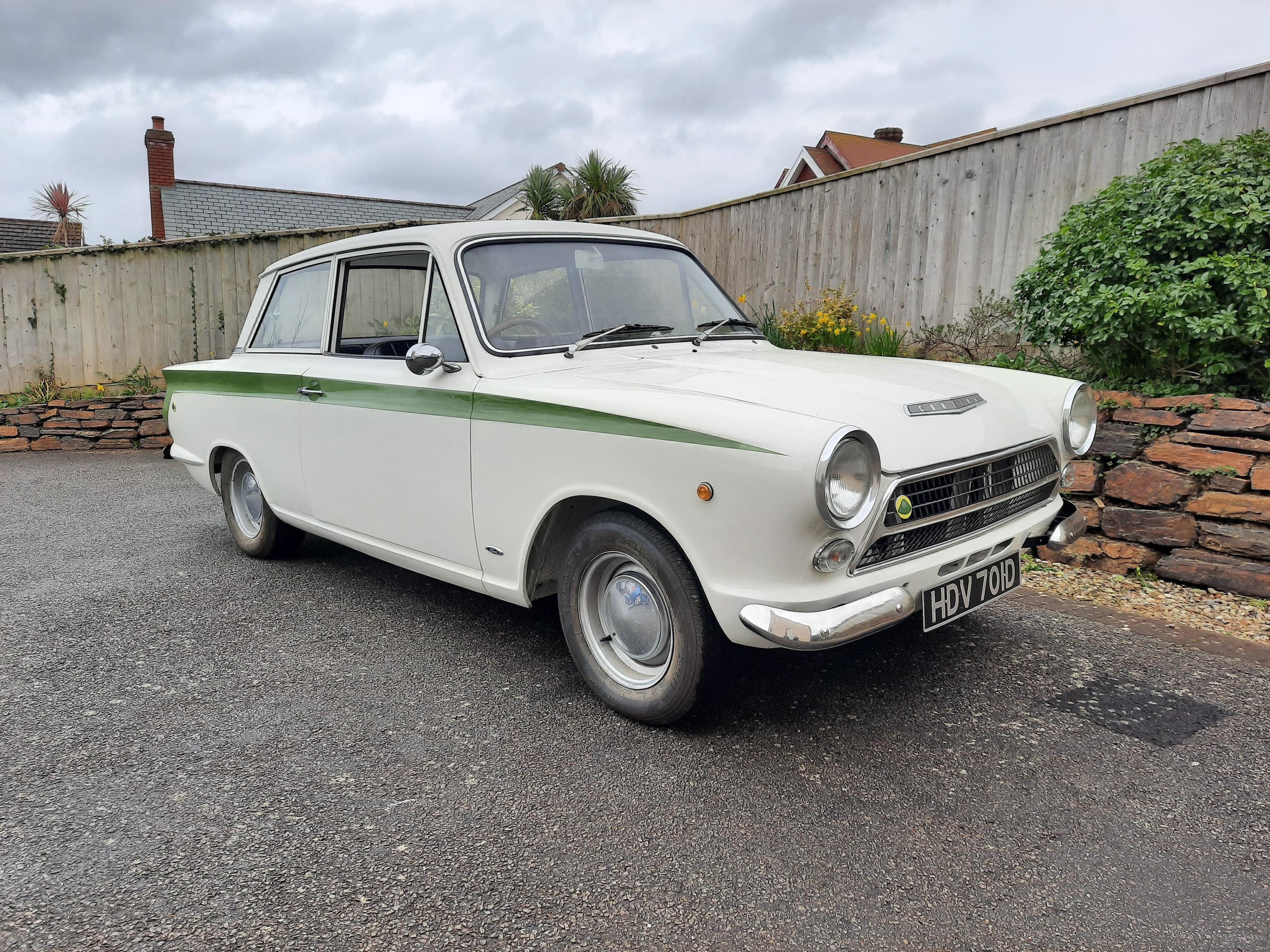1,594cc DOHC Inline 4-Cylinder Engine 2 Weber Carburetors Approximately 190bhp 4-Speed Manual Close Ratio Transmission Front Independent Suspension – Live Rear Axle Front Disc – Rear Drum Brakes *Lightweight construction, only 1822 lbs *A model raced in period by Jim Clark and Graham Hill *Quintissential mid-sixties saloon car racer *Incredible fun on a race track *Desirable late Mk I example The Lotus Type 28 The immortal Lotus Cortina by Ford of Dagenham, in England, is one of the most charismatic, best-loved and universally successful high-performance cars ever to represent the great globalized American company's famous blue-oval badge. The two-door Ford Cortina GT had already been proven in rallies and circuit racing when Ford executive Walter Hayes approached Colin Chapman to produce a world-beating racing saloon, following up a series of successful Ford-powered Lotus Formula Junior single-seaters. The plan called for Lotus to assemble 1000 cars to homologate the model for FIA Group 2 racing. Engineer Harry Mundy – who had previously helped design the Formula 1 World Championship-winning Coventry Climax engines – had been commissioned by Chapman to design a twin-overhead camshaft cylinder head to top the Ford 1500 Kent engine's "unburstable bottom end". Cosworth Engineering helped develop and fine-tune these engines, while the Ford 4-speed gearbox as specified for the Lotus Elan was adopted for the Cortina program. Colin Chapman significantly revised the Ford Cortina's suspension, changing the spring and damper rates, reducing the ride height, and utilizing coil springs at the rear. The body shell was lightened with aluminium skins in the doors, hood and trunk lid. Aluminium was also adopted for the clutch housing, remote gearshift extension and differential case. Production began in February 1963, with homologation being achieved in September 1963 despite production not yet having reached the FIA's 1,000-off minimum. Graham Hill, Jackie Stewart, Vic Elford, Jack Sears, Sir John Whitmore, and Jacky Ickx all raced Cortinas. Jim Clark – multiple F1 World Champion and Indy 500 winner, also won the 1964 British Saloon Car Championship in his works version. The production Lotus Cortina was itself updated, the 1965 homologation model returning to leaf springs in place of coil-springs at the rear. The engines were tuned by 1962 F1 World Champion constructor BRM. By the end of production late in 1966 it is believed that some 2894 Lotus Cortinas had been built, virtually all finished in Ermine White with Sherwood Green body band and flash. In 1967 a Lotus Cortina Mark II followed, assembled by Ford not Lotus, and therefore not allocated a Lotus type number. The Motorcar Offered This well-prepared Series 1 Lotus Cortina was developed as a streetable vintage race car over a lengthy period by John McCoy at OmniTech Engineering of Bellevue, Washington. It has been run at various vintage events throughout the Northwest for almost 15 years, and is supplied with FIA-CACC logbooks and homologation paperwork. The constructor advises that this left-hand-drive car with the desirable live rear axle was restored to factory specifications in the early 1990s with originality in mind, retaining its original body tags and as many original components as possible. The original body was tired, so McCoy re-shelled it with very hard-to-locate OEM parts. The car is attractively finished in its original Ford color scheme of Ermine White with a Sherwood Green side flash. There is a full tubular steel roll cage which makes this car very stiff, and the interior remains factory stock with the exception of the steering wheel, seats, and carpet. The builder states that the engine is an Omnitech Stage 4 all-steel 1594cc Ford-based twin-cam producing an estimated 190hp with a very flat torque curve. It is protected by an Accusump lubrication system and an increased-capacity radiator. A lightweight flywheel with a Tilton rally clutch drives a Quaife-prepared four
1,594cc DOHC Inline 4-Cylinder Engine 2 Weber Carburetors Approximately 190bhp 4-Speed Manual Close Ratio Transmission Front Independent Suspension – Live Rear Axle Front Disc – Rear Drum Brakes *Lightweight construction, only 1822 lbs *A model raced in period by Jim Clark and Graham Hill *Quintissential mid-sixties saloon car racer *Incredible fun on a race track *Desirable late Mk I example The Lotus Type 28 The immortal Lotus Cortina by Ford of Dagenham, in England, is one of the most charismatic, best-loved and universally successful high-performance cars ever to represent the great globalized American company's famous blue-oval badge. The two-door Ford Cortina GT had already been proven in rallies and circuit racing when Ford executive Walter Hayes approached Colin Chapman to produce a world-beating racing saloon, following up a series of successful Ford-powered Lotus Formula Junior single-seaters. The plan called for Lotus to assemble 1000 cars to homologate the model for FIA Group 2 racing. Engineer Harry Mundy – who had previously helped design the Formula 1 World Championship-winning Coventry Climax engines – had been commissioned by Chapman to design a twin-overhead camshaft cylinder head to top the Ford 1500 Kent engine's "unburstable bottom end". Cosworth Engineering helped develop and fine-tune these engines, while the Ford 4-speed gearbox as specified for the Lotus Elan was adopted for the Cortina program. Colin Chapman significantly revised the Ford Cortina's suspension, changing the spring and damper rates, reducing the ride height, and utilizing coil springs at the rear. The body shell was lightened with aluminium skins in the doors, hood and trunk lid. Aluminium was also adopted for the clutch housing, remote gearshift extension and differential case. Production began in February 1963, with homologation being achieved in September 1963 despite production not yet having reached the FIA's 1,000-off minimum. Graham Hill, Jackie Stewart, Vic Elford, Jack Sears, Sir John Whitmore, and Jacky Ickx all raced Cortinas. Jim Clark – multiple F1 World Champion and Indy 500 winner, also won the 1964 British Saloon Car Championship in his works version. The production Lotus Cortina was itself updated, the 1965 homologation model returning to leaf springs in place of coil-springs at the rear. The engines were tuned by 1962 F1 World Champion constructor BRM. By the end of production late in 1966 it is believed that some 2894 Lotus Cortinas had been built, virtually all finished in Ermine White with Sherwood Green body band and flash. In 1967 a Lotus Cortina Mark II followed, assembled by Ford not Lotus, and therefore not allocated a Lotus type number. The Motorcar Offered This well-prepared Series 1 Lotus Cortina was developed as a streetable vintage race car over a lengthy period by John McCoy at OmniTech Engineering of Bellevue, Washington. It has been run at various vintage events throughout the Northwest for almost 15 years, and is supplied with FIA-CACC logbooks and homologation paperwork. The constructor advises that this left-hand-drive car with the desirable live rear axle was restored to factory specifications in the early 1990s with originality in mind, retaining its original body tags and as many original components as possible. The original body was tired, so McCoy re-shelled it with very hard-to-locate OEM parts. The car is attractively finished in its original Ford color scheme of Ermine White with a Sherwood Green side flash. There is a full tubular steel roll cage which makes this car very stiff, and the interior remains factory stock with the exception of the steering wheel, seats, and carpet. The builder states that the engine is an Omnitech Stage 4 all-steel 1594cc Ford-based twin-cam producing an estimated 190hp with a very flat torque curve. It is protected by an Accusump lubrication system and an increased-capacity radiator. A lightweight flywheel with a Tilton rally clutch drives a Quaife-prepared four















Testen Sie LotSearch und seine Premium-Features 7 Tage - ohne Kosten!
Lassen Sie sich automatisch über neue Objekte in kommenden Auktionen benachrichtigen.
Suchauftrag anlegen